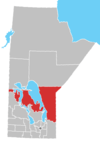Poplar River First Nation
Poplar River First Nation (or Azaadiwi-ziibi Nitam-Anishinaabe in the Anishinaabe language) is an Ojibwa First Nation in Manitoba, Canada. Poplar River First Nation is named after the Poplar River, which is the main river on which it resides.
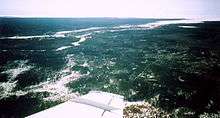
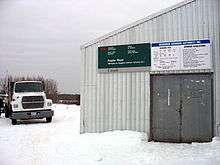
This community is often simply referred to as Poplar River, and at times is affectionately referred to as "Popular River". In addition, it is sometimes also mistakenly referred to as "Popular River".
Its landbase is the Poplar River 16 First Nation Reserve, located approximately on the east side of Lake Winnipeg at the mouth of the Poplar River. Geographically, it is located at 52°59′46″N 97°16′59″W. The largest city nearest this community is Winnipeg located approximately 400 kilometres (250 mi) to the south.
The current acting chief of Poplar River is Guy Douglas according to the band website[1] although the Government of Canada website lists Russell Lambert as the current Chief.[2] The Tribal Council affiliated with this First Nation is Southeast Resource Development Council. Poplar River is part of Treaty 5 Adhesion, signed on September 20, 1875.
Demographics
Poplar River First Nation is 3,800 acres (1,500 ha). As of 2013, the total population of registered First Nation Peoples was 1,543 with 1245 on reserve, and 298 off reserve. The primary language spoken is Ojibwe, with some blending of the Cree dialect also known as Ojicree. The majority of surnames are Bruce, Franklin, and Berens.
There is an additional population consisting of Métis and non-status First Nations residing in the community, previously having a neighbouring Métis settlement, but it was abandoned.
The community has no municipality, district or any other town associated or connected with it.
Community
The town itself is embedded along the main Poplar River with the primary township located on an atoll of land between Poplar River and Franklin River. The majority of the population resides along these two rivers, including three habitable islands located within the main Poplar River. Gravel highways exists throughout all of the community and bridges cross both rivers to connect all areas of the community. There are no paved concrete or asphalt roads or sidewalks.
Even though most people today use automobiles and walking power to travel the gravel paved roads, the use of watercraft and winter snowmobiles still remains.
Called "Asatiwisipe Aki" by the First Nation, their traditional land has been designated as a protected area with the support of the Manitoba government. It is one of the last remaining pristine river areas in the world, particularly in southern Canada. The river is very clean, with little or no man-made pollutants in the watershed. The Poplar River area may soon be designated as a section of a United Nations Heritage Site.
Environmental profile
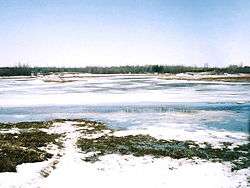
The water, land, forest and beaches continue to remain free of pollution and industrial activity.
The land is unfit for farming, so therefore self-sufficiency based on agriculture is not an option. Due to its geographic location during the Pleistocene period, or last ice age,[3] this land was located under a large glacier that ploughed away the topsoils that are necessary for agriculture. Around 10 centimetres of soil exists covering clay sediment. This is evident during the warmer summer months when clay mud is prominent throughout most of the foot-travelled areas of the community.
This community is in the Boreal Forest range of Canada,[4] is not within the region of permafrost,[5] and is geographically closer to the North Pole to allow for what is locally referred to as the Northern Lights, or the more scientific term Aurora Borealis.[6]
The people
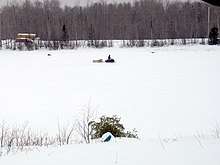
The people of Poplar River are viewed as a "proud" people. The people are non-prejudiced towards those of different backgrounds.
Younger people will often affectionately refer to Poplar River as "Poplar River #16" or simply "#16" due to the treaty adhesion number. This has been the case for many decades.
Alcoholism and drug addiction
Poplar River is a "dry" reserve, but prohibition laws are only enforced when citizens are acting irresponsibly or are a threat to others. Alcoholism occurs more prominently in certain families. There are no official studies to track alcoholism and its effects on the people.
Although alcohol can be smuggled in or obtained from bootleggers, the ease of drug smuggling is causing a dramatic increase in drug abuse causing serious addictions. The common drugs being used are marijuana, narcotic medication, cocaine and other illicit street drugs.
Health
The general overall state of health for the community is lower than the national average. Due to genetic predispositions that are known to influence the metabolism of aboriginals, the lack of education regarding proper nutrition and the importance of exercise, obesity and diabetes and all related illnesses are still a health threat to a portion of the population. Heart attacks are appearing to be more and more common-place for adults at the age of 50 years. This can be attributed to the lack of healthier choices in foods that are brought in to the community.
The extremely high rate of unemployment continues to be a problem, but this is the same for all First Nation communities. This is due to the lack of businesses or new enterprises that would normally provide employment for the people. A large portion of the population collects social assistance in order to survive, and this has been an unavoidable fact of life for many generations of families.
The community has one of the lowest suicide rates compared to other First Nation communities.
Serious criminal activity is nearly non-existent, but drug trafficking, acts of violence and spousal abuse are common-place.
Post-European contact
Historically, cross-cultural influence by early European settlers and their governments are believed to have been the source of many problems for aboriginal peoples. The attempted assimilation of aboriginals is a well-known failure, and the loss of the traditional culture and religious beliefs has created a strong sense of hostility, loss and hopelessness within many aboriginal communities.
More importantly, in more recent decades the sudden change to mainstream diet could also have negative side-effects, not just with members of this community, but for all First Nation people; on or off reserve. The introduction of additives to foods such as hormones, antibiotics, tranquilizers, excessively high sugar, salt, and other additives, and even caffeine, nicotine and alcohol, could cause chemical changes in the bodies of First Nation people interfering with mental wellness . None of these substances except nicotine existed in their lives for thousands of years. Studies have shown that chemical imbalances could lead to irrational thoughts and behaviours triggering lengthy episodes of depression, anxiety, hostility and dependence on alcohol or mood-altering prescription medication or illegal drugs . This would explain the high incidents of alcoholism, higher than average rates of suicide, as well as other social ills. A sedentary lifestyle devoid of physical exercise is also known to trigger lengthy negative emotional events. There have been no in-depth scientific studies or analysis into this particular area specifically targeted at the First Nation peoples.
It has been recently discovered that the return to traditional spiritual, cultural, familial and dietary lifestyles could provide a more healthy way of life for aboriginal communities. While fishing and hunting has been practised by the elders, this knowledge is being taught and passed on to future generations. The preservation of the Ojibwa dialect is also paramount, and the return to traditional spiritual healing ceremonies and medicines may also remedy the mental, physical and emotional ills that are of great concern to the community. These teachings are ongoing.
The people in this community still persevere to overcome adversity today.
Facts
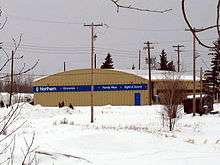
Northern, or The North West Company, is the largest business selling general merchandise ranging from household goods, food, petroleum products, electronics, clothing and more. Its predecessor was Hudson's Bay Company. The costs of goods in this community are higher than the Canadian average due to having to ship products via airplane, barge (during the summer months) or truck (during the winter months) from the main distribution outlets in Selkirk or Winnipeg, which are hundreds of kilometres south.
- Mitasosipe Trading Post is the second largest store selling general merchandise.
- Negginan Harbour Authority Inc. is the main small craft docking station which is officially governed by Fisheries and Oceans Canada.
- Poplar River Elder's Lodge is a care facility for Poplar River's elderly population.
- During the winter months, Poplar River is accessible via Winter Road. It is accessible year round via airplane, and via barge or water vessels during the summer months.
- The majority of residents have modern conveniences of running water, plumbing and trash removal.
- This community does not recycle.
- Children attend Poplar River Elementary School from grade 1 to 9. This school features a modern gymnasium, library and standard education programs. Members who pursue education beyond grade 9 must attend high schools, universities or colleges off reserve.
- Most members of this community are still highly fluent in their first tongue, Ojibwe language.
- Persons of non-First Nation descent, or members of other First Nations who have decided to make Poplar River their home adapt very well, and members are quick to welcome and embrace newcomers.
- Most members of this community have broadband internet access. In addition, many households own satellite receivers for their television entertainment needs.
- Youth of this community are influenced by national and international pop culture including music, movies and fashion trends from around the world thanks to satellite television and the internet.
- the two main religions practiced in Poplar River are Roman Catholic and Pentecostal
History of chiefs and councillors
| Date | Chief | Councillors | Notes |
|---|---|---|---|
| November 3, 2015 | Clifford Bruce, James Mitchell, Guy Douglas, Emile Mason, Leonard Budd and Fred Mitchell. | ||
| November 3, 2011 | Russell Lambert | Eddie Hudson, Clifford Bruce, Emile Mason, Guy Douglas, Sophia Rabliauskas and Darrell Bruce. | |
| November 3, 2002 | Russell Lambert | Clifford Bruce, Emile Mason, James Mitchell, Leonard Budd, Edwin Mitchell and Eddie Hudson. | |
| November 3, 2000 | Vera Mitchell | James Mitchell, Fred Mitchell, Guy Douglas, Emile Mason, Edwin Mitchell and Clifford Bruce. | |
| November 3, 1998 | Vera Mitchell | James Mitchell, Eddie Hudson, Guy Douglas, Fred Mitchell, Norman Bittern and Melvin Berens. | |
| November 3, 1996 | Russell Lambert | Norman Bittern, Eddie Hudson, Irvine Franklin, James Mitchell, Emile Mason and Guy Douglas. | |
| November 3, 1994 | Russell Lambert | Irvine Franklin, George Franklin, Albert Bittern, James Mitchell, Guy Douglas and Melvin Berens. | |
| November 3, 1992 | Alex Hudson Sr. | Viola Bittern, Leonard Budd, Guy Douglas, Alex Timothy Hudson, Mary Eleanor Lambert and Emile Mason. | |
| November 3, 1990 | Vera Mitchell | Melvin Berens, Guy Douglas, Ernest C. Bruce, Leonard Mitchell, Eleanor Lambert and Alex Timothy Hudson. | |
| November 3, 1988 | Vera Mitchell | Leonard Mitchell, Norway Bittern, Guy Douglas, Albert Bittern, Melvin Bittern and Eddie Hudson. | |
| November 3, 1986 | Alex Hudson | Eddie Hudson, Marc Hudson, Gordon Bittern Sr., Fred Mitchell, Peter Bittern and Albert Bittern. | |
| November 3, 1984 | Alex Hudson | Fred Mitchell, Gordon Bittern Sr., Marc Hudson and Leonard Budd. | |
| November 3, 1982 | Alex Hudson | Leonard Budd, Gordon Bittern, Mark Hudson and Freddie Mitchell. | |
| November 3, 1980 | Albert Bittern | Phillip Bruce, William Fontaine, Margaret Hudson and Irvine Franklin. | |
| November 3, 1978 | Albert Bittern | Peter Bittern, Jimmy Bruce, Phillip Bruce and Leonard Budd. | |
| November 3, 1976 | Norman Walter Bruce | Albert Bittern, Solomon Bruce, Franklin Mitchell and William Paul. | Norman W. Bruce resigned 1/6/77. |
| November 3, 1974 | George Boyd | Albert Bittern, Leonard Budd, Austin Franklin and Vernon George Franklin. | George Boyd resigned 3/3/75; Jacob Green appt Chief 1/4/75 Leonard Budd resigned 3/7/75. Austin Franklin resigned 31/7/75. Lillian Bittern and Norman W. Bruce elected 28/8/75. Jacob Green resigned 16/3/76 & Norman W. Bruce appt 31/3/76. |
| November 3, 1974 | George Boyd | Leonard Budd, Albert Bittern, Austin Franklin and Walter Nanowin. | |
| November 3, 1972 | Gordon Bittern | Valerie Boyd, Bert Bruce, Lawrence Bruce and Colin Bruce. | Valerie Boyd resigned 19/11/73. Gordon Bittern, Bert Bruce, Colin Bruce and Lawrence Bruce resigned 11/4/74. |
| October 21, 1970 | Alex Hudson | Lillian Bittern, Philip Bruce and Victor Bruce. | Alex Hudson resigned 13/9/71 and Philip Bruce appt. as Chief. |
| October 22, 1966 | Gordon Bittern | Bert Bruce, Norman Bruce and Philip Bruce. | Norman Bruce resigned 16/10/67 Vernon Franklin replaced him. Alex Hudson Chief 7/10/68. Vernon Franklin and Victor Bruce resigned 8/2/70. William Fontaine and William Bruce replaced councillor 27/2/70. |
| October 20, 1962 | Gordon Bittern | William Bruce and Fred Lambert. | |
| October 20, 1960 | Alex Hudson | Bruce and Leonard Mitchell. | |
| October 27, 1958 | Jacob Bruce | William Bruce and Alex Mitchell. | |
| October 18, 1956 | Gordon Bittern | Councillors Roderick Douglas and Charles Franklin. | |
| November 23, 1953 | Alex Hudson | Fred Lambert and William Bruce. | |
| June 12, 1950 | Jacob Bruce and Thomas Douglas. | ||
| June 17, 1933 | Cuthbert Nanowin | Jacob Bruce and James Bruce. | |
| August 12, 1926 | Miles Michel | Sandy Bruce and Cuthbert Nanowin. | |
| August 19, 1924 | Miles Michel and Cuthbert Nanowin. | ||
| 1914 | Jacob Nanowin and Miles Michel. | ||
| 1913 | Jacob Nanowin. | ||
| July 11, 1912 | Jacob Nanowin and Henry Bittern. | ||
| July 25, 1885 to August 24, 1923 | Jacob Nanowin. | Death of Jacob Nanowin was shown on paylist 24/8/23. |
Official address
Poplar River First Nation
P.O. Negginan
Poplar River, Manitoba R0B 0Z0
Phone: 204-244-2267
Fax: 204-244-2690
official web site
References
- "Poplar River First Nation". prfn.ncsl.ca. Retrieved 2015-09-05.
- "Governance". pse5-esd5.ainc-inac.gc.ca. Archived from the original on 2015-04-02. Retrieved 2015-09-05.
- "Image: glacial_maximum_map2.jpg, (700 × 658 px)". cosmographicresearch.org. Retrieved 2015-09-05.
- "Image: map-boreal-general.png, (1250 × 794 px)". borealbirds.org. Archived from the original on 2015-09-23. Retrieved 2015-09-05.
- https://www.nrcan.gc.ca/sites/www.nrcan.gc.ca/files/earthsciences/jpg/assess/2007/ch3/images/fig1_e.jpg
- "Image: solar_maximum_forecasts_lg.jpg, (720 × 406 px)". canadiangeographic.ca. Archived from the original on 2015-09-23. Retrieved 2015-09-05.
External links
- Aboriginal Peoples Television Network
- Assembly of First Nations
- Famous Native Americans
- Weshki-ayaad's Introduction to Ojibwe Language and Culture
- First Perspective - Aboriginal News
- Fisheries and Oceans Canada
- Indian and Northern Affairs
- Manitoba Aboriginal and Northern Affairs
- NCI FM - Native Communications Inc.
- The North West Company
- Poplar River First Nation
- Southeast Community Futures Development Corporation
- The Weather Network - Poplar River First Nation Weather
- Map of Poplar River 16 at Statcan
